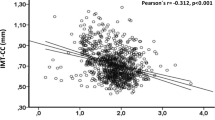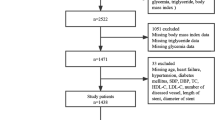Abstract
Obese individuals, despite having increased cardiovascular (CV) risk factors experience adverse CV outcomes less frequently than non-obese. Little is known about association of long-term weight gain to development of coronary artery disease (CAD), inflammation and thrombogenicity. 418 consecutive patients with suspected CAD undergoing elective cardiac catheterization were included in a sub-analysis of the multi analyte, thrombogenic, and genetic markers of atherosclerosis study. Maximum weight gain (MWG) was defined as percentage increase in weight since age 17 years to year of heaviest weight and categorized as: minor (<30 %), moderate (30–47 %), severe (>47–69 %), and extreme (>69 %). Lipid profiling was determined by vertical density gradient ultracentrifugation, thrombin-induced platelet fibrin clot strength (TIP–FCS) by thrombelastography, and urinary 11-dehydrothromboxane B2 (11-dhTxB2) by ELISA. CAD severity was defined as minimal (<20 %), moderate (20–75 %), and severe (>75 %) luminal diameter obstruction of any major coronary vessel. The mean MWG was 53 ± 33 %. Extreme MWG group had a higher incidence of diabetes mellitus (48 %), hypertension (81 %), depression (25 %), and were most often female (60 %) (p < 0.05 for all). In women, CAD severity was inversely associated to MWG (p = 0.05), whereas in men no such association was observed (p = 0.18). TIP–FCS increased in a stepwise fashion with MWG (p = 0.001). 11-dTxB2 levels were higher in the extreme MWG group, regardless of lipid lowering therapy (p < 0.05). Our data suggest that maximal weight gain since age 17 years is associated with heightened thrombogenicity, inflammation and a poorer lipid profile but not an increased risk for severe CAD development.




Similar content being viewed by others
References
Peeters A, Barendregt JJ, Willekens F, Mackenback JP, Mamun AA, Bonneux L (2003) Obesity in adulthood and its consequences for life expectancy: a life-table analysis. Ann Intern Med 138(1):24–32
Calle EE, Thun MJ, Petrelli JM, Rodriguez C, Heath CW Jr (1999) Body-mass index and mortality in a prospective cohort of U.S. adults. N Engl J Med 341(15):1097–1105
Lee IM, Manson JE, Hennekens CH, Paffenbarger RS Jr (1993) Body weight and mortality: a 27-year follow-up of middle-aged men. JAMA 270(23):2823–2828
Pencina M, D’Agostino RB, Fox CS, Vasan RS, Kannel WB (2009) Obesity is independently associated with long-term risk of cardiovascular mortality and underweight with risk of non-cardiovascular mortality in Framingham Offspring Cohort [abstract 1466]. Circulation 120:S508
Gruberg L, Weissman NJ, Waksman R, Fuchs S, Deible R, Pinnow EE, Ahmed LM, Kent KM, Pichard AD, Suddath WO, Satler LF, Lindsay J Jr (2002) The impact of obesity on the short-term and long-term outcomes after percutaneous coronary intervention: the obesity paradox? J Am Coll Cardiol 39:578–584
Romero-Corral A, Montori VM, Somers VK, Korinek J, Thomas RJ, Allison TG, Mookadam F, Lopez-Jimenez F (2006) Association of bodyweight with total mortality and with cardiovascular events in coronary artery disease: a systematic review of cohort studies. Lancet 368:666–678
Bucholz EM, Rathore SS, Reid KJ, Jones PG, Chan PS, Rich MW, Spertus JA, Krumholz HM (2012) Body mass index and mortality in acute myocardial infarction patients. Am J Med 125:796–803
Kovacic JC, Lee P, Baber U, Karajgikar R, Evrard SM, Moreno P, Mehran R, Fuster V, Dangas G, Sharma SK, Kini AS (2012) Inverse relationship between body mass index and coronary artery calcification in patients with clinically significant coronary lesions. Atherosclerosis 221:176–182
Akin I, Tölg R, Hochadel M, Bergmann MW, Khattab AA, Schneider S, Senges J, Kuck KH, Richardt G, Nienaber CA, DES.DE (German Drug-Eluting Stent) Study Group (2012) No evidence of “obesity paradox” after treatment with drug-eluting stents in a routine clinical practice: results from the prospective multicenter German DES.DE (German Drug-Eluting Stent) registry. J Am Coll Cardiol Intv 5(2):162–169
Romero-Corral A, Somers VK, Sierra-Johnson J, Jensen MD, Thomas RJ, Squires RW, Allison TG, Korinek J, Lopez-Jimenez F (2007) Diagnostic performance of body mass index to detect obesity in patients with coronary artery disease. Eur Heart J 28(17):2087–2093
Pischon T, Boeing H, Hoffmann K, Bergmann M, Schulze MB, Overvad K, van der Schouw YT, Spencer E, Moons KG, Tjønneland A, Halkjaer J, Jensen MK, Stegger J, Clavel-Chapelon F, Boutron-Ruault MC, Chajes V, Linseisen J, Kaaks R, Trichopoulou A, Trichopoulos D, Bamia C, Sieri S, Palli D, Tumino R, Vineis P, Panico S, Peeters PH, May AM, Bueno-de-Mesquita HB, van Duijnhoven FJ, Hallmans G, Weinehall L, Manjer J, Hedblad B, Lund E, Agudo A, Arriola L, Barricarte A, Navarro C, Martinez C, Quirós JR, Key T, Bingham S, Khaw KT, Boffetta P, Jenab M, Ferrari P, Riboli E (2008) General and abdominal adiposity and risk of death in Europe. N Engl J Med 359:2105–2212
Heitmann BL, Frederiksen P (2009) Thigh circumference and risk of heart disease and premature death: prospective cohort study. BMJ 339:b3292
Lim Soo, Choi SH, Kim KM, Choi SI, Chun EJ, Kim MJ, Park KS, Jang HC, Sattar N (2014) The association of rate of weight gain during early adulthood with the prevalence of subclinical coronary artery disease in recently diagnosed type 2 diabetes: the MAXWEL-CAD study. Diabetes Care 37(9):2491–2499
Freedman DS, Khan LK, Dietz WH, Srinivasan SR, Berenson GS (2001) Relationship of childhood obesity to coronary heart disease risk factors in adulthood: the Bogalusa Heart Study. Pediatrics 108(3):712–718
Nambi V, Chambless L, Folsom AR, He M, Hu Y, Mosley T, Volcik K, Boerwinkle E, Ballantyne CM (2010) Carotid intima-media thickness and presence or absence of plaque improves prediction of coronary heart disease risk: the ARIC (atherosclerosis risk in communities) study. J Am Coll Cardiol 55(15):1600–1607
Gurbel PA, Bliden KP, Kreutz RP, Dichiara J, Antonino MJ, Tantry US (2009) The link between heightened thrombogenicity and inflammation: pre-procedure characterization of the patient at high risk for recurrent events after stenting. Platelets 20:97–104
Stein PD, Beemath A, Olson RE (2005) Obesity as a risk factor in venous thromboembolism. Am J Med 118:978–980
Ferrante AW (2007) Obesity-induced inflammation: a metabolic dialogue in the language of inflammation. J Intern Med 262:408–414
Sarno G, Lagerqvist B, Nilsson J, Frobert O, Hambraeus K, Varenhorst C, Jensen UJ, Tödt T, Götberg M, James SK (2014) Stent thrombosis in new-generation drug- eluting stents in patients with STEMI undergoing primary PCI: a report from SCAAR. J Am Coll Cardiol 64(1):16–24. doi:10.1016/j.jacc.2014.04.022
Wang ZJ, Zhou YJ, Liu YY, Yu M, Shi DM, Zhao YX, Guo YH, Cheng WJ, Nie B, Ge HL, Jia DA, Yang SW, Yan ZX (2009) Obesity and cardiovascular thrombotic events in patients undergoing percutaneous coronary intervention with drug-eluting stents. Heart 95(19):1587–1592
Arbab-Zadeh A, Texter J, Ostbye KM, Kitagawa K, Brinker J, George RT, Miller JM, Trost JC, Lange RA, Lima JA, Lardo AC (2010) Quantification of lumen stenoses with known dimensions by conventional angiography and computed tomography implications of using conventional angiography as gold standard. Heart 96:1358–1363
Gurbel PA, Bliden KP, Navickas IA, Mahla E, Dichiara J, Suarez TA, Antonino MJ, Tantry US, Cohen E (2010) Adenosine diphosphate-induced platelet-fibrin clot strength: a new thrombelastographic indicator of long-term poststenting ischemic events. Am Heart J 160:346–354
Rivard GE, Brummel-Ziedins KE, Mann KG, Fan L, Hofer A, Cohen E (2005) Evaluation of the profile of thrombin generation during the process of whole blood clotting as assessed by thrombelastography. J Thromb Haemost 3:2039–2043
Swinkels DW, Demacker PNM, Hendricks JCM, van’t Laar A (1989) Low density lipoprotein subtractions and relationship of other risk factors for coronary artery disease in healthy individuals. Arteriosclerosis 9:604–613
Gardner CD, Fortmann SP, Krauss RM (1996) Small low density lipoprotein particles are associated with the incidence of coronary artery disease in men and women. JAMA 276:875–881
Austin MA, Brunzell JD, Fitch WL, Krauss RM (1990) Inheritance of low density lipoprotein subclass patterns in familial combined hyperlipidemia. Arteriosclerosis 10:520–553
Austin MA, Breslow JL, Hennekens CH, Buring JE, Willett WC, Krauss RM (1988) Low- density lipoprotein subclass patterns and risk of myocardial infarction. JAMA 260:1917–1921
Chrono-log Corporation (2005) Instruction manual for the chrono-log model 490 optical aggregometers. Havertown, PA, USA, p 31
Davì G, Guagnano MT, Ciabattoni G, Basili S, Falco A, Marinopiccoli M, Nutini M, Sensi S, Patrono C (2002) Platelet activation in obese women: role of inflammation and oxidant stress. JAMA 288(16):2008–2014
Vandanmagsar B, Youm YH, Ravussin A, Galgani JE, Stadler K, Mynatt RL, Ravussin E, Stephens JM, Dixit VD (2011) The NLRP3 inflammasome instigates obesity-induced inflammation and insulin resistance. Nat Med 17:179–188
Graziani F, Biasucci LM, Cialdella P, Liuzzo G, Giubilato S, Della Bona R, Pulcinelli FM, Iaconelli A, Mingrone G, Crea F (2011) Thromboxane production in morbidly obese subjects. Am J Cardiol 107:1656–1661
Acknowledgments
This study was supported by Platelet and Thrombosis Research, LLC and Haemonetics. VAP© testing was provided by Atherotech® Inc. Urinary 11-dehydrothromboxane B2 and AtherOx testing were provided by Corgenix Medical Corp. We wish to acknowledge Tania Gesheff, RN, MSN, Kiran Kalra, MBBS, and Cescelle Barbour RN, MSN for their contributions to this study.
Author information
Authors and Affiliations
Corresponding author
Ethics declarations
Conflicts of interest
Dr. Gurbel reports serving as a consultant for Daiichi Sankyo/Lilly, Bayer, AstraZeneca, Accumetrics, Merck, Medtronic, Janssen, CSL, and Haemonetics; receiving grants from the National Institutes of Health, Daiichi Sankyo, Lilly, CSL, AstraZeneca, Haemetics, Harvard Clinical Research Institute, and Duke Clinical Research Institute; receiving payment for lectures, including service on speakers’ bureaus, from Lilly, Daiichi Sankyo, and Merck; receiving payment for development of educational presentations from Merck, the Discovery Channel, and Pri-Med; Dr. Gurbel is holding stock or stock options in Merck, Medtronic, and Pfizer; and holding patents in the area of personalized antiplatelet therapy and interventional cardiology. Dr. Gurbel has received consulting fees from Corgenix Medical Corp. Dr. Toth reports either serving as a consultant and/or on speakers’ bureau for Amarin, GSK, Aegerion, Amgen, AstraZeneca, Kowa, Liposcience, and Merck. No other authors report any potential conflicts of interest.
Rights and permissions
About this article
Cite this article
Chaudhary, R., Bliden, K.P., Tantry, U.S. et al. Association of weight gain with coronary artery disease, inflammation and thrombogenicity. J Thromb Thrombolysis 41, 394–403 (2016). https://doi.org/10.1007/s11239-015-1327-y
Published:
Issue Date:
DOI: https://doi.org/10.1007/s11239-015-1327-y




